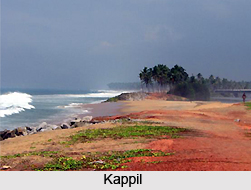 Kappil is the city located in the north-west border town of Thiruvananthapuram district, in Kerala. Kappil is located in Edava Panchayat at the coast of Arabian Sea, near Varkala.
Kappil is the city located in the north-west border town of Thiruvananthapuram district, in Kerala. Kappil is located in Edava Panchayat at the coast of Arabian Sea, near Varkala.
Kappil is 50 odd kilometres away from Trivandrum City. It is located 7 kilometres north of the famous tourist destination, Varkala Beach. This is the place where backwaters and Beach can be seen together. The natural landscape view is stunning; on one side one have waves roaring on the beach of Kappil and other side one see calm fresh natural water lake.
The scenic backwaters, beach and facilities for water sport and adventure tourism allure the tourists. Nellatil, Edava, Paravur, Nadayara, Varkala etc. are locations in the vicinity which are worth visiting for a weekender. .
Kappil is accessible by anyone when one travel through Trivandrum-Kollam. Kappil and Kappil Beach is a place where one will get the adventure and excitement. The magical interplay of land and water, the coconut tree covered islets; people using small country boats for commute and for fishing are images that will never leave the memory of a weekender.
Kappil is the best kept secret of God"s own country- Kerala and one really wish it to be like that. Kappil is a favourite place of the National Cadet Corps and regular parasailing and adventure water sports activities are held there under the sponsorship of Indian Air Force.
Kappil is said as “the soul of India lives in its villages“, by Mohandas Karamchand Gandhi (Mahatma Gandhi-Father of Indian Nation) at the beginning of 20th Century. As one will wind up the day, a sojourn at this beautiful place, will realize one that can touches the heart and stirs the soul.
Kappil is also famous for Kappil Bhagavathy Temple and a tourist spot during the festival season of Onam and other major festivals of Kerala.
Kappil is easily accessible through the railways, roadways and waterways. Kappil is easily connected with railways. Only shuttle trains stop at Kappil. It lies on the Thiruvananthapuram - Kollam railway route. The nearest main railway station is Paravur at 4.5 kilometres away. The Paravur Railway Station is an “Adersh Railway Station†in India. The bus service is available to Thiruvananthapuram which is 65 kilometres, Kollam is 30 kilometres, Paravur is 4.5 kilometres away and Varkala, is 10 kilometers The nearest airport is Thiruvananthapuram International Airport. From this international airport, this city of leisure tourism is well connected.



















